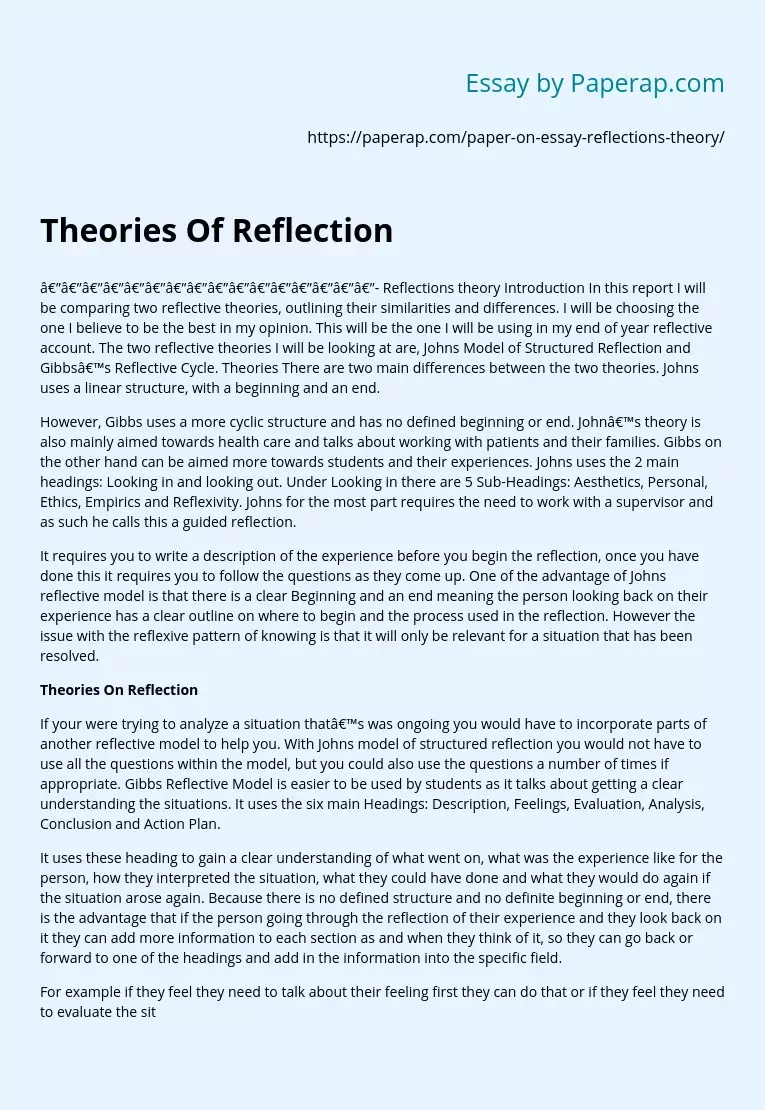Theories Of Reflection
————————————————- Reflections theory Introduction In this report I will be comparing two reflective theories, outlining their similarities and differences. I will be choosing the one I believe to be the best in my opinion. This will be the one I will be using in my end of year reflective account. The two reflective theories I will be looking at are, Johns Model of Structured Reflection and Gibbs’s Reflective Cycle. Theories There are two main differences between the two theories. Johns uses a linear structure, with a beginning and an end.
However, Gibbs uses a more cyclic structure and has no defined beginning or end. John’s theory is also mainly aimed towards health care and talks about working with patients and their families. Gibbs on the other hand can be aimed more towards students and their experiences. Johns uses the 2 main headings: Looking in and looking out. Under Looking in there are 5 Sub-Headings: Aesthetics, Personal, Ethics, Empirics and Reflexivity. Johns for the most part requires the need to work with a supervisor and as such he calls this a guided reflection.
It requires you to write a description of the experience before you begin the reflection, once you have done this it requires you to follow the questions as they come up. One of the advantage of Johns reflective model is that there is a clear Beginning and an end meaning the person looking back on their experience has a clear outline on where to begin and the process used in the reflection.
However the issue with the reflexive pattern of knowing is that it will only be relevant for a situation that has been resolved.
Theories On Reflection
If your were trying to analyze a situation that’s was ongoing you would have to incorporate parts of another reflective model to help you. With Johns model of structured reflection you would not have to use all the questions within the model, but you could also use the questions a number of times if appropriate. Gibbs Reflective Model is easier to be used by students as it talks about getting a clear understanding the situations. It uses the six main Headings: Description, Feelings, Evaluation, Analysis, Conclusion and Action Plan.
It uses these heading to gain a clear understanding of what went on, what was the experience like for the person, how they interpreted the situation, what they could have done and what they would do again if the situation arose again. Because there is no defined structure and no definite beginning or end, there is the advantage that if the person going through the reflection of their experience and they look back on it they can add more information to each section as and when they think of it, so they can go back or forward to one of the headings and add in the information into the specific field.
For example if they feel they need to talk about their feeling first they can do that or if they feel they need to evaluate the situation or talk about what they would do again, and add their input to it, as they can go through the cycle as many times as they need to get all the information down. Gibbs also talks about what would we do different if the situation arose again. They both put great emphasis on the feelings and the emotions of the person throughout the reflection process. They both talk about what happened and try to make sense of the situation. They both also talk about Conclusion
To conclude the theory that I will be choosing for my reflective practice at the end of year is, Gibbs Reflective Cycle. I have chosen this reflective model for a number of reasons. I believe that Gibbs reflective cycle is more aimed towards Student whereas Johns is aimed more towards health care and talks about working with patients and their families. Gibbs reflective model is also easier to interpret and I believe it to be easier to use to analyze any given situation with the main headings it uses to gain information about the situation the feelings of the person and the experience the person underwent during any given situation.
I believe it is easier to follow than Johns model of structured reflection. Gibbs reflective cycle does not require the need of a supervisor to aid the reflection whereas; John’s model talks about have one present to go through the reflection process. I will be using Gibbs Reflective cycle as I feel that it is more relevant to myself and it is clearer to follow and would be easier to use for my reflection process. References (2012) REFLECTION.
Available: http://moodle. bcu. ac. uk/tee/pluginfile. php/116376/mod_resource/content/0/reflective_models. pdf. Last accessed 15th Dec 2012. (2012) About Johns’ model of structured reflection. Available: http://www. brookes. ac. uk/services/upgrade/a-z/reflective_johns. html. Last accessed 16th Dec 2012. (2012) About Gibbs reflective cycle. Available: http://www. brookes. ac. uk/services/upgrade/a-z/reflective_gibbs. html. Last accessed 16th Dec 2012.
Theories Of Reflection. (2019, Dec 05). Retrieved from https://paperap.com/paper-on-essay-reflections-theory/

